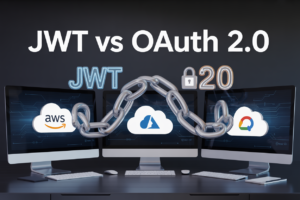🚨 Danger lurks in the shadows of your databases! 💾
In today’s data-driven world, your organization’s most valuable asset is its information. But what if that information is at risk? From RDS to DynamoDB, Aurora to Redshift, and ElastiCache, each database system faces unique security challenges that could compromise your data integrity, confidentiality, and availability.
Imagine waking up to find your customer data leaked, financial records altered, or entire databases held for ransom. The consequences could be devastating – loss of trust, financial ruin, and irreparable damage to your reputation. But it doesn’t have to be this way. By understanding the top security threats to popular database systems and implementing robust mitigation strategies, you can fortify your data fortress and sleep soundly at night.
In this comprehensive guide, we’ll delve into the specific vulnerabilities plaguing RDS, DynamoDB, Aurora, Redshift, and ElastiCache. We’ll explore common database security threats, uncover system-specific risks, and arm you with best practices and advanced mitigation strategies to keep your data safe. Are you ready to take control of your database security? Let’s dive in and discover how to protect your most precious digital assets.
Common Database Security Threats
A. SQL Injection Attacks
SQL injection attacks remain one of the most prevalent and dangerous threats to database security. These attacks exploit vulnerabilities in application code to manipulate SQL queries, potentially granting unauthorized access to sensitive data or even full control of the database.
Common types of SQL injection attacks include:
- Union-based
- Error-based
- Blind SQL injection
- Time-based blind SQL injection
To mitigate SQL injection risks:
- Use parameterized queries
- Implement input validation
- Employ stored procedures
- Utilize least privilege principles
| Attack Type | Description | Mitigation |
|---|---|---|
| Union-based | Combines results of multiple queries | Use parameterized queries |
| Error-based | Exploits error messages for information | Disable detailed error messages |
| Blind SQL injection | Infers data through true/false questions | Implement input validation |
| Time-based blind | Uses time delays to infer information | Utilize stored procedures |
B. Unauthorized Access
Unauthorized access poses a significant threat to database security, potentially leading to data theft, manipulation, or destruction. This risk is particularly relevant in cloud environments where misconfigurations can expose databases to the internet.
C. Data Breaches
Data breaches can result from various vulnerabilities, including weak authentication, unencrypted data storage, and insider threats. The consequences of a data breach can be severe, ranging from financial losses to reputational damage.
D. Malware and Ransomware
Malware and ransomware attacks targeting databases can encrypt or destroy critical data, disrupting operations and potentially leading to data loss. These threats often exploit vulnerabilities in outdated software or gain access through phishing attacks.
Now that we’ve covered the common database security threats, let’s examine the specific risks associated with RDS.
RDS-Specific Security Risks
A. Misconfigured Security Groups
Misconfigured security groups pose a significant risk to RDS instances, potentially exposing sensitive data to unauthorized access. Here are key points to consider:
-
Common misconfigurations:
- Overly permissive inbound rules
- Unnecessary open ports
- Inappropriate IP range allowances
-
Impact of misconfiguration:
- Increased attack surface
- Potential data breaches
- Compliance violations
| Best Practice | Description |
|---|---|
| Least Privilege | Grant minimal necessary access |
| Regular Audits | Periodically review and update rules |
| Automated Monitoring | Use tools to detect and alert on misconfigurations |
B. Unencrypted Data in Transit
Protecting data in transit is crucial for maintaining RDS security. Unencrypted data can be intercepted and compromised by malicious actors.
- Use SSL/TLS encryption for all database connections
- Enforce encryption at the application level
- Regularly update and rotate SSL certificates
C. Weak Authentication Mechanisms
Robust authentication is essential for securing RDS instances. Weak mechanisms can lead to unauthorized access and potential data breaches.
-
Common weak authentication practices:
- Use of default credentials
- Weak password policies
- Lack of multi-factor authentication (MFA)
-
Strengthening authentication:
- Implement strong password policies
- Enable and enforce MFA for all users
- Regularly rotate credentials
- Use IAM database authentication for enhanced security
Now that we’ve covered RDS-specific security risks, let’s examine the vulnerabilities associated with DynamoDB, another popular AWS database service.
DynamoDB Vulnerabilities
Access Key Exposure
Access key exposure is a critical vulnerability in DynamoDB that can lead to unauthorized access and data breaches. This issue often arises from poor key management practices or accidental disclosure of credentials. To mitigate this risk:
- Implement key rotation policies
- Use AWS Secrets Manager for secure storage
- Enable AWS CloudTrail for auditing key usage
| Risk Factor | Impact | Mitigation |
|---|---|---|
| Exposed Access Keys | Unauthorized database access | Regular key rotation |
| Compromised Credentials | Data theft and manipulation | Multi-factor authentication |
| Insider Threats | Potential data leakage | Least privilege principle |
Inadequate IAM Policies
Poorly configured IAM policies can leave DynamoDB tables vulnerable to unauthorized access and data manipulation. To strengthen IAM policies:
- Implement the principle of least privilege
- Regularly audit and review IAM policies
- Use condition keys to restrict access based on specific criteria
Data Leakage Through APIs
APIs can inadvertently expose sensitive DynamoDB data if not properly secured. To prevent data leakage:
- Implement API Gateway with proper authentication
- Use VPC endpoints to restrict API access
- Encrypt data in transit using HTTPS
By addressing these vulnerabilities, organizations can significantly enhance their DynamoDB security posture. Now, let’s explore the unique security challenges faced by Aurora databases.
Aurora Security Challenges
Replication Vulnerabilities
Aurora’s multi-master replication feature, while powerful, can introduce security challenges if not properly managed. Replication vulnerabilities can lead to data inconsistencies, unauthorized access, or even data breaches.
- Potential risks:
- Asynchronous replication delays
- Cross-region replication security gaps
- Inconsistent security configurations across replicas
To mitigate these risks, consider implementing:
- Regular audits of replication configurations
- Encryption of data in transit between replicas
- Consistent security policies across all replica instances
| Risk | Mitigation Strategy |
|---|---|
| Replication delays | Monitor lag times and set alerts |
| Cross-region gaps | Implement VPC peering and encryption |
| Inconsistent configs | Use automated configuration management |
Unsecured Backups
Backups are crucial for data recovery, but they can become a security liability if not properly secured. Unsecured Aurora backups can expose sensitive data to unauthorized access or theft.
Key considerations for backup security:
- Encryption of backups at rest
- Access controls for backup storage
- Regular testing of backup integrity and restore processes
Insufficient Monitoring
Inadequate monitoring of Aurora databases can leave security gaps undetected. Comprehensive monitoring is essential for identifying potential threats and anomalies in real-time.
Effective monitoring strategies include:
- Implementing AWS CloudTrail for API activity logging
- Utilizing Amazon CloudWatch for performance and security metrics
- Setting up alerts for suspicious activities or configuration changes
By addressing these Aurora-specific security challenges, you can significantly enhance your database protection. Next, we’ll explore the unique security concerns associated with Amazon Redshift.
Redshift Security Concerns
Unencrypted Data at Rest
Redshift’s data-at-rest encryption is a crucial security feature that many organizations overlook. Without encryption, sensitive data stored in your Redshift cluster becomes vulnerable to unauthorized access. To mitigate this risk:
- Enable AWS Key Management Service (KMS) for Redshift
- Use AWS-managed or customer-managed keys for encryption
- Regularly rotate encryption keys
Inadequate Network Isolation
Proper network isolation is essential for protecting your Redshift cluster from external threats. Common isolation issues include:
- Exposed cluster to public internet
- Overly permissive security groups
- Lack of VPC peering controls
To address these concerns:
- Use VPC with private subnets
- Implement strict security group rules
- Utilize VPC endpoints for secure access
Insecure Data Loading Processes
| Risk | Mitigation |
|---|---|
| Unencrypted data transfer | Use SSL/TLS for all connections |
| Unsecured S3 buckets | Implement S3 bucket policies and encryption |
| Weak IAM roles | Create least-privilege IAM roles for data loading |
Weak User Access Controls
Inadequate user access management can lead to data breaches and unauthorized modifications. Strengthen your Redshift access controls by:
- Implementing multi-factor authentication (MFA)
- Regularly auditing user permissions
- Utilizing AWS Identity and Access Management (IAM) for fine-grained access control
- Enabling database-level user management
By addressing these Redshift-specific security concerns, you can significantly enhance the protection of your data warehouse. Next, we’ll explore the unique security risks associated with ElastiCache and how to mitigate them effectively.
ElastiCache Security Risks
Cache Poisoning Attacks
Cache poisoning attacks pose a significant threat to ElastiCache systems. These attacks occur when malicious actors manipulate cached data, potentially leading to the distribution of corrupted information to users. To mitigate this risk:
- Implement input validation
- Use HTTPS for all communications
- Regularly flush and refresh cache data
- Set appropriate Time-to-Live (TTL) values
| Attack Method | Mitigation Strategy |
|---|---|
| Query string manipulation | Sanitize input parameters |
| HTTP header injection | Validate and encode headers |
| DNS cache poisoning | Use DNSSEC and secure DNS resolvers |
Insufficient Access Controls
Inadequate access controls can leave ElastiCache vulnerable to unauthorized access and data breaches. To strengthen access controls:
- Implement least privilege principle
- Use strong authentication mechanisms
- Regularly audit and review access permissions
- Employ multi-factor authentication for sensitive operations
Data Exposure in Transit
Protecting data during transmission is crucial for ElastiCache security. Failure to secure data in transit can lead to interception and unauthorized access. To address this vulnerability:
- Enable in-transit encryption for all ElastiCache clusters
- Use VPC peering or AWS PrivateLink for secure connections
- Implement proper network segmentation
- Regularly rotate SSL/TLS certificates
By addressing these ElastiCache security risks, organizations can significantly enhance their database protection. Next, we’ll explore best practices for overall database security across various AWS database services.
Best Practices for Database Security
Implement Strong Encryption
Encryption is the cornerstone of database security. For AWS databases, implement encryption at rest and in transit:
- At-rest encryption: Use AWS Key Management Service (KMS) to manage encryption keys.
- In-transit encryption: Enable SSL/TLS for all database connections.
| Database Service | Encryption at Rest | Encryption in Transit |
|---|---|---|
| RDS | AWS KMS | SSL/TLS |
| DynamoDB | AWS-managed keys | HTTPS |
| Aurora | AWS KMS | SSL/TLS |
| Redshift | AWS KMS | SSL |
| ElastiCache | Redis AUTH | In-transit encryption |
Use IAM Roles and Least Privilege Access
Implement the principle of least privilege using AWS Identity and Access Management (IAM):
- Create specific IAM roles for different database access levels
- Assign minimal permissions necessary for each role
- Regularly audit and rotate access keys
- Use temporary credentials when possible
Enable Database Auditing and Monitoring
Comprehensive auditing and monitoring are crucial for detecting and responding to security threats:
- Enable AWS CloudTrail for API call logging
- Use Amazon CloudWatch for real-time monitoring
- Set up alerts for suspicious activities
- Implement AWS Config for compliance monitoring
Regularly Update and Patch Systems
Keep your database systems up-to-date to protect against known vulnerabilities:
- Enable automatic minor version upgrades
- Schedule maintenance windows for major updates
- Regularly review and apply security patches
- Test updates in a staging environment before production deployment
With these best practices in place, you’ll significantly enhance the security posture of your AWS databases. Next, we’ll explore advanced mitigation strategies to further fortify your database defenses.
Advanced Mitigation Strategies
Implement Database Firewalls
Database firewalls are a crucial line of defense against unauthorized access and potential threats. They act as a barrier between your database and potential attackers, filtering traffic based on predefined rules.
| Feature | Benefit |
|---|---|
| Real-time monitoring | Immediate threat detection |
| Custom rule sets | Tailored protection for specific needs |
| Anomaly detection | Identifies unusual patterns quickly |
To maximize the effectiveness of your database firewall:
- Regularly update firewall rules
- Monitor firewall logs for suspicious activity
- Integrate with other security tools for comprehensive protection
Utilize Data Masking Techniques
Data masking is an essential strategy for protecting sensitive information within your databases. This technique replaces real data with fictitious but realistic data, maintaining the database’s integrity while safeguarding critical information.
- Static data masking: Applied to test or development environments
- Dynamic data masking: Applied in real-time as data is accessed
Employ Intrusion Detection Systems
Intrusion Detection Systems (IDS) are vital for identifying potential security breaches. These systems monitor network traffic and database activities, alerting administrators to suspicious behavior.
Key features of effective IDS:
- Real-time monitoring and alerting
- Pattern recognition for known attack signatures
- Anomaly detection for identifying unusual activities
Conduct Regular Security Audits
Regular security audits are crucial for maintaining a robust security posture. These audits help identify vulnerabilities and ensure compliance with security policies.
| Audit Type | Focus Area |
|---|---|
| Vulnerability assessment | Identifying system weaknesses |
| Penetration testing | Simulating real-world attacks |
| Compliance audit | Ensuring adherence to regulations |
Implement Multi-Factor Authentication
Multi-Factor Authentication (MFA) adds an extra layer of security by requiring users to provide multiple forms of identification before accessing the database.
Common MFA methods:
- Something you know (password)
- Something you have (security token)
- Something you are (biometric data)
Implementing these advanced mitigation strategies will significantly enhance your database security across various AWS services, including RDS, DynamoDB, Aurora, Redshift, and ElastiCache. By combining these techniques, you create a comprehensive defense against evolving security threats in the cloud environment.




















